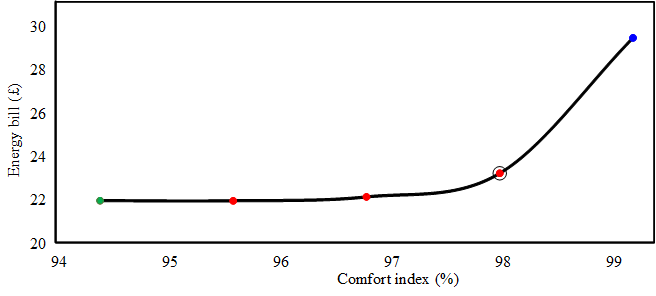Active and low carbon buildings can create energy flexibility, reduce emissions, and decrease energy bills. Yet there is an important factor that should be considered; to achieve net zero carbon, we must reduce emissions and be more energy efficient without having a negative impact on the occupants’ comfort. So, how can we achieve our targets in energy management and control of buildings while respecting occupants’ comfort?
How occupant comfort affects building energy management
In any building, be that a standard Victorian terrace or a modern zero carbon unit, visual, thermal, and air quality are three important factors that impact on the occupant’s comfort. Visual comfort is provided by lighting appliances, while heating ventilation and air conditioning (HVAC) units can be responsible for providing thermal and air quality comfort.
Due to the considerable share of HVAC units in energy consumption, energy management and control strategies for buildings are mostly targeting such devices. Indeed, optimal control of HVAC units is crucial in decreasing energy bills and providing ancillary services for energy distribution systems. However, their operation is directly linked to occupants’ comfort and improper management can result in complaints from building users. Therefore, it is important to consider occupant’s comfort when targeting economic and environmental goals in energy management of buildings and their energy systems.
Including occupants’ comfort in building energy management
Considering this fact, our team at Newcastle University has developed an energy management system for groups of low and zero carbon buildings which can consider occupant comfort as its main goal. Our system optimally controls the operation of smart appliances (e.g. washing machine), and comfort providing units (e.g. HVAC units). To explore the effect of occupant comfort on economically driven targets, we have considered simultaneously minimising the energy bill and maximising comfort levels as the objectives of energy management strategy.
Meanwhile the question that arises here is how to deal with two goals simultaneously? In another words, how to quantify the degree of importance of each goal? The answer may be to give a weighting to each objective function. Indeed, varying this weighting can shine a light on the degree of importance placed on economically driven and occupants’ comfort related targets.
The following figure (figure1) shows the results of our energy management strategy with different weightings considered – cost and occupant comfort.

The conflicts of cost and comfort
As can be seen, if we apply a higher weighting to the comfort index (marked with blue in figure 1), the energy bill increases. This is indeed how our buildings currently perform, where a thermostat adjusts the temperature to the preferred set-points given by occupants. On the contrary, if we focus on the economic targets (marked with green), the comfort index drops. Although more cost effective, this set point might not be acceptable for building users and could prove uncomfortable for them. The lowest bill is not always the best bill in this context. It is important to note here that these two objectives are in conflict, i.e., optimising one of them adversely affects the other one. So, what can we do in such circumstances?
The key is to make a compromise between these two goals. Taking a more balanced approach, as per the red points in figure 1, a compromise can be found. We need to consider occupant preferences and select a suitable solution. We can also follow decision making theories, like an interactive fuzzy satisfying method, to select a “best” compromise solution. Such an approach allows us to make a trade-off automatically without having to set weightings to these objectives every day. We have applied this method and highlighted the outcomes in figure 1 with the circled red point.
The role of building occupants in automatic control
Finally, an important fact underlying this work is the role of automatic occupant comfort control in achieving different targets. A small change in expectation can create considerable difference. For instance, when the comfort index is decreased by one percent (i.e., from 99% to 98%), the energy bill exponentially decreases. This clearly demonstrates the importance of the occupants in building energy management.
With any other objectives we have in mind for energy management within buildings, such as providing ancillary services for the wider energy network, the building occupants’ preference is the decisive factor. Occupants’ behavioural flexibility is a key factor in decarbonising buildings and our achieving net-zero targets.
Saman Nikkhah is a postgraduate research student at Newcastle University where he focuses on the role of active buildings in the energy network as part of the Active Building Research Programme.


